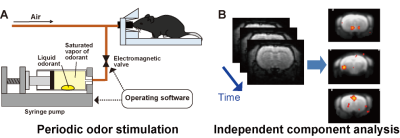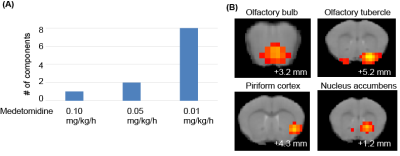Yumiko Tsubakihara1, Mitsuhiro Takeda1, Sosuke Yoshinaga1, and Hiroaki Terasawa1
1Faculty of Life Sciences, Kumamoto University, Kumamoto, Japan
1Faculty of Life Sciences, Kumamoto University, Kumamoto, Japan
Muscone is
an odorant that attracts male mice. Muscone-evoked activations were identified in
the mouse whole brain, using periodic stimulation and independent component
analysis under medetomidine anesthesia.

Fig. 2 (A) Schematic illustration of the
automated odor stimulation system. A drop of odorant solution is placed within a
syringe pump, and the syringe becomes saturated with vapor. The saturated vapor
is infused into the animals by operating the syringe pump and the
electromagnetic valve. (B) Independent component analysis. Activations were
detected as periodically occurring responses, even in the presence of large
noise signals.

Fig. 3 (A) Number of muscone-evoked activations detected
in the olfactory bulb and the olfactory cortex under different levels of
medetomidine anesthesia. (B) Representative
activation map detected at the 0.01 mg/kg/h medetomidine concentration, in the olfactory
bulb, the piriform cortex, the olfactory tubercle, and the nucleus accumbens. In each slice, the distance from the bregma is
shown at the bottom right of the panel.